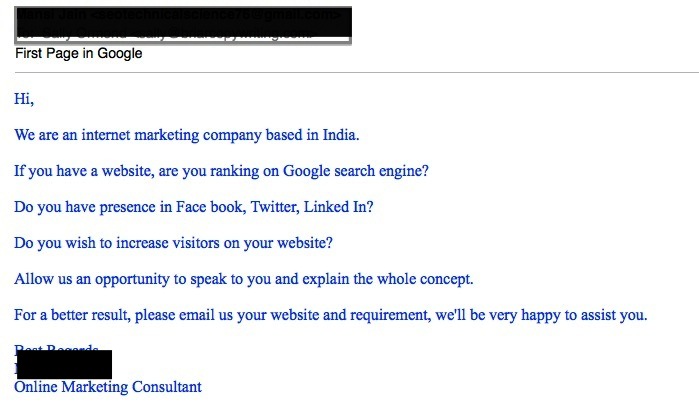Entries from February 2014 ↓
February 28th, 2014 — email copywriting, email marketing
You may think it rather odd that I’m writing about the failure rate of spam emails.
Well, the reason for my madness is that you can learn a lot from the spammers about how not to do email marketing.
When you send out emails to potential clients, do you think carefully about your subject lines, presentation and content before hitting send?
I’m not going to go into detail about how to make your email marketing work, if you follow that link you’ll find a post that tells you all about that, instead I want to take an example of a spam email and highlight the areas the sender has got wrong.
You see if you get the same areas wrong your emails could end up looking like spam and that’s something you want to avoid at all costs.
Are you ready?
Here’s the email – I have blanked out names to save blushes.

Before I talk about the areas you can see, I would like to point out that although this apparently came from a company, the email was a gmail.com address. If you are a legitimate company you should have a company specific email address, i.e. Joe@velocitylighting.com not velocitylighting@gmail.com.
Subject line
The first thing I want to look at is the subject line. This sender has used “First Page in Google”.
First off no one can guarantee a first page ranking in Google, so instantly, I can smell spam.
It’s not a descriptive subject line either; it doesn’t entice me to click on it to learn more. If you want people to open your emails your subject line must grab their attention.
Greetings
What about the salutation?
“Hi”.
That shows this is a blanket email they’ve sent to all and sundry. When sending out your email campaign make sure you address the recipient my name. This should be easy because you’ll be using your own list rather than a random one you’ve bought in (won’t you?).
It may seem a small thing, but addressing someone by his or her name will go a long way to build trust.
Email content
Then we get into the body of the email. Again, you can instantly see this email is a blanket mailing because it’s asking if I have a website, is it ranking, do I use Facebook, Twitter or LinkedIn? Again, if they knew me they’d already know the answers to those questions.
Yet another fail.
They then go on to ask for the opportunity to speak to me and explain the whole concept. What concept?
- Having a website?
- Ranking in Google?
- Using Facebook, Twitter and LinkedIn?
- Increasing visitors to my website?
There are so many issues it’s impossible to know exactly what they’re offering because there is no focus.
The most powerful emails (landing pages, web pages etc.) focus on one idea. Any more than that and you begin to dilute your message.
It’s also important to watch your English, spelling and grammar. Look at the last line:
“For a better result, please email us your website and requirements, we’ll be very happy to assist you.”
How can I email them my website? I can email the URL, but not the physical website. Plus, this again shows they have done no research whatsoever on my business, because if they had, they’d know my web address.
Signing off
Last, but not least, look at the signature at the bottom.
I know the sender is an Online Marketing Consultant, but I have no idea from which company – no branding – yet another epic fail.
Hopefully, looking at this obvious spam email has helped you understand more about how email communications should be written and the pitfalls you must avoid if you want to be taken seriously.
Author: Sally Ormond
February 26th, 2014 — blog, blogging, blogging for business

This is a question I’m asked a lot.
Should it be short and sweet, or should it be a lengthy, complicated in depth look at a particular topic?
On top of that, should it be conversational and friendly, or should it be strictly professional and formal?
There are no right or wrong answers.
Everyone loves different things.
Personally, I prefer short, chatty and informative posts that get across a point or concept quickly and easily.
A long blog post, no matter how well written, will never hold my attention because I always have a pile of stuff to get through so I don’t have the time to sit and wade through complex arguments and ideas.
Yet there are people out there who love long posts.
The best piece of advice I can give is to take a look at the audience you are writing for. What do they like? If your company deals with high brow financial, medical or complex issues, your writing will probably be more formal than if you were involved in design or marketing. But that doesn’t mean to say all your posts have to be long and ‘dry’ (in the nicest possible sense of the word). Throw in a few short, pithy posts now and then to liven things up and add interest.
That’s really all I have to say.
Over to you – what type of blog posts do you prefer? Leave a comment below and tell me what industry you write for and the main type of post you publish.
I’d be really interested in your input on this one.
Author: Sally Ormond, copywriter at Briar Copywriting Ltd.
February 24th, 2014 — marketing, website copywriter, website copywriting
Last month I wrote a blog about the rise of friendvertising using the video from Dove to illustrate how big brands are using the power of social media to get you to do their advertising for them by sharing their content.
Watch the video now and then I’m going to ask you something.
Moving, isn’t it?
It’s incredible how these women see one thing and yet the artist sees something completely different.
And that’s what got me thinking.
You’ve been working in your business for many years, you know it inside out, but are you seeing the same thing as your customers?
How do they perceive you?
Getting your message out loud and clear
The video shows how easy it is to be caught up in your own world and be blind to what it is other people are seeing.
Take a good look at your business. Not how it’s run (although that will have an effect on how you are perceived), but how it is marketed to the world.
Let’s start with your website.
Does it look OK?
Just OK?
How about your brochures, business cards, leaflets, newsletters and emails, do they look OK too?
I bet they tell your customers all about your business, your products and your services.
They tell them how long you’ve been in business, that you’re an expert in your field and that you’re passionate about what you do.
So what do you think that tells your customers?
That you’re innovative, have their interests at heart, will do everything you can to help them?
No.
All that tells your customers is that you love your company.
The power of you
You is a short word, but one that packs a powerful punch.
Making sure your website copywriting (and all your marketing materials) is written in the second person will create an entirely different perception.
Instead of being told “We have many years experience in the development of software solutions”, which will send your potential customers to sleep, you will excite them by saying “We’ll create software systems that work the way you want them to, saving you time and money.”
Straight away they can see the benefit in what you do because, rather than telling them what you do, you are telling them what you can do for them.
You are showing them you are a company that cares about its customers. Suddenly, them emphasis is on them and not on you.
It’s a far more powerful message.
Everything you write must be about your customer.
Every message must highlight the benefits you will bring to their lives or their business.
Every word must show them that you care about them and that’s the whole reason you’re in business.
February 21st, 2014 — Google, Google algorithms, Link Building
Google is getting tough. Unnatural links are being penalised, but it’s not just the small businesses that are being hit, there’s been a few bigger scalps recently.
The one I want to draw your attention to is the UK banking chain, Halifax.
According to a recent article in CognitiveSEO, the UK’s largest provider of residential mortgages and savings accounts has felt Google’s wrath. Its link building strategy has been deemed as not being very Google friendly and is now facing a major online upheaval.
The article shows that the Halifax experienced a significant SEO drop at the beginning of February.
It would appear as though in December of last year, Halifax received a huge increase in new links – over 400,000, but only from 190 referring domains. Then, at the end of January, its number of lost links suddenly spiked. This was probably in reaction to Google’s penalty.
Unnatural links will cause Google to take a closer look at your website and if you have over 20% unnatural links you’ll be classed as high risk and will be flagged by the Google algorithm.
What happened?
After a bit of digging, CognitiveSEO identified 3 dodgy link building strategies used by the banking giant.
- 1. Web directory links
- 2. Easily pattern-able links
- 3. Advertorials (paid posts)
You can read the full story here.
So as this case study has shown, no one is exempt from Google’s penalties and that’s why it’s essential you adopt good link building techniques.
February 19th, 2014 — Content marketing, Content writer

Before I answer that, I want you to think about content.
What is it?
Well, as far as I can tell there are 2 types:
- Sales content – website copy, brochure content, emails etc.
- Marketing content – blogs, articles, case studies etc.
Vastly different?
Not really, but that doesn’t stop most people from deciding one is worth investing in and the other isn’t.
It’s a given that your website copy, brochure content, email marketing etc., should be professionally written because they are key to converting readers into customers.
Most companies see that as a worthwhile investment, but when it comes to content generation things seem to change.
You already know that to be an effective online marketer you need to produce content regularly.
What you may not know is that content must be what your customers want to read. So we’re not talking about press releases that talk about your latest achievements, plugs for your latest product or service thinly disguised as blog posts, or self-serving social media updates.
Peanuts don’t make prizes
The cheapest way to get a continuous supply of content for your business is to create it in-house.
That’s great if you happen to have some very talented writers on your payroll. But not every company has that resource.
There are companies out there that will generate loads of content for you for peanuts.
Result!
Only if you want generic, low quality articles that won’t enhance your reputation.
“But I only need it for the search engines.”
If that’s your attitude, you’ve missed the point of content marketing completely.
Today, marketing isn’t about “hey, this is what we sell, this is how to get in touch with us, so buy, buy, buy.”
Now your customers want more; they want to build a relationship with you, get to know you and feel as though they can trust you. They want to talk to you, engage with you and have a bit of banter.
That’s right – marketing is now a two way street.
The blogs and articles that you once thought unimportant (because they’re just for the search engines) are hugely important. They are what make or break your brand’s reputation.
If you publish low quality generic articles, people won’t become engaged with your brand so they won’t buy.
But if you publish high quality content that’s useful, they’ll lap it up.
You see, content is content whichever way you look at it. If you pay peanuts for it, it will fail.
Author: Sally Ormond – Briar Copywriting







